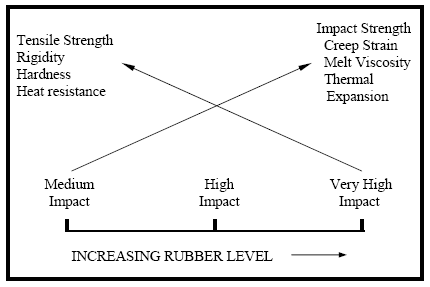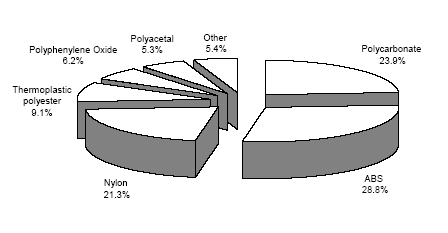Related Resources: 3D Printing
ABS Plastic Filament Engineering Information
ABS Plastic 3D Printer Filament Engineering Information
Acrylonitrile Butadiene Styrene
ABS is a low cost engineering plastic that is easy to machine and 3D print. ABS is an ideal material for structural applications where impact resistance, strength, and stiffness are required. ABS is one of the most successful of the engineering thermoplastics available. It is a bridge between commodity plastics (e.g., polystyrene) and higher-performing engineering thermoplastics (e.g., polycarbonate). Its position in terms of both properties and price between the more highly priced, high performance engineering plastics and the lower priced commodity plastics makes ABS the material of choice for many applications (Adams et al., 1993).
ABS resins are composed of over 50% styrene and varying amounts of butadiene and acrylonitrile. Styrene provides rigidity and ease of processability, acrylonitrile offers chemical resistance and heat stability, and butadiene supplies toughness and impact strength. ABS having high rubber content possesses higher impact strength than those with low content of rubber. Increase in rubber content results in greater ductility of these blends. Large-volume applications for ABS resins include plastic pipe and automotive and appliance parts. Although ABS has many desired properties as engineering thermoplastic, its still has some limitation for example, easily burn with high flammability value and poor resistance to outdoor UV light (Chanda and Roy, 1993).
ABS is manufactured with various levels of rubber. Major tradeoffs for ABS with increasing rubber level is:

Blending of ABS with other polymers is widely reported and many engineering studies have been carried out on various blends. As of 2010, ABS commanded a significant portion of the engineered plastics demand (Freedonia Industry Study).

The basic chemisrty of ABS plastic is:

Manufacturing ABS: ABS polymers can be prepared by mechanical blending of the individual components or by grafted polymerization of a mixture of styrene with acrylonitrile in the presence of suitable rubber component. There are three commercial polymerization processes for manufacturing ABS: emulsion, suspension and bulk. The most common technique for producing the grafted polybutadiene phase is emulsion polymerization.
Mechanical Properties of ABS Plastic
The overall toughness offered by ABS materials is the prime mechanical property that prompts most users to select ABS for their applications. The standard measure of impact strength used for ABS is notched Izod impact strength, as measured by ASTM D256A. Depending on its impact strength, material is classified as very high-, high- or medium-impact polymer. As pointed out previously, its value determines in which class of standard product a material belongs. Although ABS is notch sensitive, it is much less so than many other polymers, including polycarbonate and nylon. In addition to good impact strength at room temperature, ABS retains significant impact strength at very low temperatures (Svec et al., 1990). This has led to the use of ABS in critical low-temperature applications. ABS materials can deform in a ductile manner over a broad temperature range and at high strain rates.
Thermal Properties of ABS Plastic
The critical thermal properties for ABS are heat distortion, coefficient of linear thermal expansion, thermal endurance, thermal conductivity, and specific heat. The most common measure of heat distortion is the deflection temperature under load as measured by ASTM D648. High-heat ABS, ABS/polycarbonate (PC) alloys, and ABS/styrene-maleic anhydride (SMA) alloys all extend applications of ABS into the temperature up to 110oC at 1.8 MPa for short-term exposures (Jenker and Köln, 1983).
Flammability of ABS Plastic
ABS has a low LOI index with a range of 17-18 % (Pál and Macskásy, 1991). ABS materials without flame retardant are easily burned with a luminous yellow flame, smoking strongly and continue to burn after removal of the ignition source. The high impact ABS will has a smell of burnt rubber (Troitzsch, 1980).
Typical 3D Printing temperatures and Filament Tolerances
3D printing temperature range from 220 - 245 ° C nozzle with heated bed.
Industry standard filament diameters are 1.75mm or 2.85mm ± 0.10mm , roundness is typically between 4%.
Recommended: 245° C nozzle and 95° C heated bed. Generally, a 3D printer enclosure helps to normalize the printing environment temperature. On 3D printing conclusion, the heated bed temperature is lowered to approximately 60° C for release.
3D Filament Comparison Table for ABS and PLA
|
Property
|
ABS
(Acrylonitrile Butadiene Styrene) |
PLA
(Polylatic Acid) |
|
Density ρ (Mg/m3)
|
1.00 - 1.22
|
1.24
|
|
Young’s Modulus E (GPa)
|
1.12 - 2.87
|
3.53
|
|
Elongation at break (%)
|
3 - 75
|
6.05
|
|
Melting (softening) Temperature ( °C)
|
88 - 128
|
159
|
|
Glass Transition Temperature ( °C)
|
100
|
60
|
|
Yield Stress σy (MPa)
|
18.5 - 51
|
-
|
|
Tensile Strength σts (MPa)
|
25 - 50
|
36 - 55
|
|
Ultimate Tensile Strength (MPa)
|
33 - 110
|
35
|
|
Fracture Toughness (Plane strain) (MPa√m)
|
1.19 - 4.3
|
-
|
|
Thermal expansion (μm/mK)
|
83 - 95
|
-
|
|
Strength to weight ratio (kNm/ kg)
|
31 - 80
|
40
|
|
Shear modulus (GPa)
|
3180-
|
24
|
The following are typical engineering characteristics of FDA compliant ABS
|
Property
|
ASTM Test Method
|
Units
|
Nominal Value
|
|
Density
|
D-1505
|
g/cc
|
1.03
|
|
Tensile Strength at Yield
|
D-638
|
psi
|
> 6000
|
|
Elongation at Break
|
D-638
|
%
|
40
|
|
Flexural Modulus
|
D-790
|
psi
|
300,000
|
|
Flexural Yield Strength
|
D-790
|
psi
|
10,700
|
|
Durometer
|
D-785
|
R scale
|
102
|
|
Izod Impact
|
D-256
|
ft - lbs / in2
|
7.7
|
|
Vicat Softening Temp.
|
D-1525
|
°F
|
219°
|
|
Heat Defection Temp.
at 66 psi |
D-648
|
°F
|
201°
|
|
Flammability
|
UL-94
|
UL94
|
HB
|
Related
- Learning to Get Great 3D Prints
- 3D Printing with ABS Filament
- 3D Additive Printing Manufacturing | 3D Additive Printing Manufacturing
- Storing ABS and PLA 3D Printing Filament
- Storing ABS and PLA 3D Printing Filament
- 3D Printing for Superalloys
- 3D Printing Manufacturing of Aerospace Alloys
- Mostly 3D Printed (Plastic) Router CNC built in house